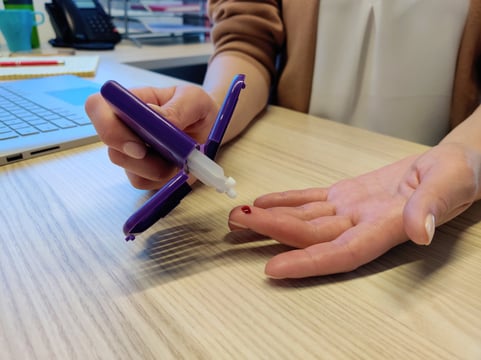Share this
perceived patient adherence improves with app and remote microsampling
by Neoteryx Microsampling on Nov 13, 2023 9:00:00 AM
An article by Ingvild Andrea Kindem et al at the Oslo University Hospital in Norway about their study on improving patient adherence was published in the August 2023 edition of Pediatric Transplantation. The research group evaluated the combined use of remote blood sample collection and a novel patient adherence app called TusenTac® as a way to encourage patients to consistently take their medications and to routinely collect their own blood samples so that providers could monitor the therapy.
 The study paper was entitled “Optimizing medication adherence with home-monitoring – A feasibility study using capillary microsampling and mHealth in solid organ-transplanted adolescents.”
The study paper was entitled “Optimizing medication adherence with home-monitoring – A feasibility study using capillary microsampling and mHealth in solid organ-transplanted adolescents.”
The medication adherence study showed a 35% conversion of non-adherent patients (self-reported) to adherence during the study and a 70% improvement among cohorts (self-reported) in timing-adherence during the study.
Concerns About Medical Non-Adherence
It is well understood that one of the great aims of self-collection of blood samples using remote volumetric capillary microsampling devices, such as the Mitra® or hemaPEN®, is that this convenient, patient-centric approach will contribute to improved medical adherence. One aspect of this hypothesis is that allowing patients to self-sample at home will empower them to actively contribute to their medical regimen or at least act as a reminder to regularly take their medication.
Indeed, as reported in our technical blog on adherence to antihypertensive drugs, in 2003 the World Health Organization (WHO) reported that worldwide medication adherence rates averaged at around 50%. In the same report, the WHO stated that people would benefit more from efforts to reduce non-adherence than they would from efforts focused on developing new treatments.
Unfortunately, non-adherence rates are high among patients that have received solid organ transplants, where adherence to medication regimens is critical to preventing their bodies from rejecting the transplants. The co-authors of the study paper reviewed here commented that several studies reported non-adherence rates ranging from 2%-67% in solid organ transplant cohorts.
They highlighted a large study, which showed that 58% of renal graft loss in both adolescents and young adults was attributed to non-adherence to anti-rejection medication. Indeed, in their paper they commented that although there had been important advances in the treatment of transplant patients over the last few decades, post-graft survival rates remain stubbornly unchanged (5-10 years).
As evidenced by renal graft loss data, non-adherence is particularly problematic in adolescent and young adult cohorts. The reason for this is complex, but part of it relates to the challenge of asking young patients to take on personal responsibility for their own health at such an early age.
Other reasons that contribute to non-adherence rates in young patients include issues such as forgetfulness in individuals who have not yet effectively created set routines in their lives. As a result, groups such as the International Pediatric Nephrology Association (IPNA), recommend multimodal interventions to improve adherence rates and thus, hopefully, increase graft survival rates.
 To investigate how to improve non-adherence rates in adolescent and young adult patient populations, the team at Oslo Hospital embarked on a study utilizing a multimodal approach.
To investigate how to improve non-adherence rates in adolescent and young adult patient populations, the team at Oslo Hospital embarked on a study utilizing a multimodal approach.
This approach involved developing and deploying a mobile health app to encourage an improved drug regimen.
This approach also employed at-home blood sample collection using Mitra microsampling devices based on VAMS® technology, with 10 µL VAMS tips, to measure trough levels of the anti-rejection medication tacrolimus (Tac) in blood samples.
The Oslo Hospital research group stated that methods for Mitra devices with VAMS had previously been validated successfully in their center in studies of both adult and pediatric populations to measure tacrolimus levels. This earlier success with VAMS sampling and validation gave the research group hope that the combination of a digital app and convenient, routine sample collection at home would increase drug adherence among their study cohorts.
Adherence Study Method and Outcomes
- The group created a mobile medication management app (TusenTac®) in collaboration with the Center for Information Technology (USIT) at the University of Oslo.
- TusenTac allowed users to set dosing times and receive medication reminder alerts 15 minutes before the scheduled time and then every 15 minutes after until the medication had been taken and subsequently reported.
- The app was also designed to be a fully-fledged medication manager, including the following features:
-
- Age-adapted information to aid accessibility of transplant knowledge
- Recording of selected patient variables such as tacrolimus, and creatinine blood levels, weight, and blood pressure
- Fun facts and gamification to encourage adherence
- A clear data dashboard so patients could track their progress
- N=20 patients took part in the study; the median age was 17 (14.5-24.8) and 60% were female.
- Percent CV of tacrolimus (TacCV%) was collected for one year before the study and one year after, to see if the study had changed these trough level variances.
- In the first and final week (week 8) of the study, participants took part in a self-reported adherence questionnaire and interview using the Basel Assessment of Adherence to Immunosuppressive Medication Scale (BAASIS©).
- During the first and final weeks, wet venous blood and dried capillary blood Tac measurements were compared, as well as eGFR (venous collection) to measure renal function.
- During weeks 2-7, using the TusenTac® app, patients registered their daily Tac doses and completed an evaluation questionnaire, to rate how well they liked using the app.
- Mitra samples were collected at home to measure weekly trough levels to ascertain TacCV% during the study.
- The difference between wet venous blood and dried capillary blood collected on Mitra was only 2.1% with a 95% confidence interval of −2.3% to 6.6%.
- Only two samples out of 118 collected were rejected by the laboratory due to under sampling.
- Three samples were not obtained as they were not trough samples, and seven samples were not obtained under steady state conditions.
- The vast majority (90%) of the samples were used for the TacCV% analysis for the project.
- The participants registered their dosing in 9/10 times in the app.
- The participants also rated the app as 8.1 out of 10 and 80% said they would continue to use the app.
- 65% of participants continued to use the app for the following two months.
- The BAASIS© questionnaire showed that at the beginning of the study, 11 out of the 20 participants were nonadherent. However, 4 of these 11 became adherent during the intervention period of the study.
- 70% of the participants reported improved timing adherence.
- There was no change in the TacCV% values.
Highlights of Adherence Study Authors’ Discussion
This is the first study showing adolescent organ transplant recipients conducting home sampling. The excellent concordant results showed that the home sampling was reliable and accurate. Even though there were no differences in the TacCV%, there were a number of limitations of the study.
Limitations included the fact that the intervention period was quite short. Further, the TacCV% value before the study was 20%, which could be a sign that the cohort was too adherent in the first place to have had a significant impact on the TacCV% levels. It is also possible that simply participating in the study made participants more adherent. Gender may have been another influencing factor. It has been shown that females tend to be more adherent, and the study cohort was 60% female.
Although it was impossible to tease out the relative contribution of home sampling compared to app use, the overall improvement in self-reported adherence demonstrated the importance of multimodal interventions to improve adherence. The dropout rate of this study was only 9%, which appears to be an improvement on the 43% dropout rate of a metanalysis of published app-based intervention studies of chronic diseases.
The study authors concluded that home-monitoring with the combination of a mobile manager app and at-home Tac capillary microsampling was “feasible and led to improved perceived medication timing adherence among 70% of the transplanted adolescents during the intervention.”
Microsampling Technical Director’s Comments
There has always been a great hope that remote capillary blood sampling can contribute to improved medical adherence. This is the first study, to our knowledge, which has shown promise that home sampling coupled to a personalized digital app can improve self-reported adherence. This is, of course, multifactorial and will require more studies to confirm improved adherence. However, it is encouraging to think that not only does at-home blood sampling for therapeutic drug monitoring (TDM) improve the quality of life for graft patients, but it may also improve their overall graft health and even save lives.
This blog includes content curated from a published study paper that was summarized for our readers by James Rudge, PhD, Microsampling Technical Director, Trajan. To learn more about the important research discussed here, please visit the original article in Pediatric Transplantation.
Image Credits: Trajan, Neoteryx, iStock
Share this
- Microsampling (206)
- Research, Remote Research (119)
- Venipuncture Alternative (105)
- Clinical Trials, Clinical Research (83)
- Mitra® Device (73)
- Therapeutic Drug Monitoring, TDM (51)
- Dried Blood Spot, DBS (39)
- Biomonitoring, Health, Wellness (30)
- Infectious Disease, Vaccines, COVID-19 (24)
- Blood Microsampling, Serology (23)
- Omics, Multi-Omics (21)
- Decentralized Clinical Trial (DCT) (20)
- Specimen Collection (18)
- Toxicology, Doping, Drug/Alcohol Monitoring, PEth (17)
- Skin Microsampling, Microbiopsy (14)
- hemaPEN® Device (13)
- Preclinical Research, Animal Studies (12)
- Pharmaceuticals, Drug Development (9)
- Harpera Device (7)
- Industry News, Microsampling News (5)
- Antibodies, MAbs (3)
- Company Press Release, Product Press Release (3)
- Environmental Toxins, Exposures (1)
- July 2025 (1)
- May 2025 (1)
- April 2025 (2)
- December 2024 (2)
- November 2024 (1)
- October 2024 (3)
- September 2024 (1)
- June 2024 (1)
- May 2024 (1)
- April 2024 (4)
- March 2024 (1)
- February 2024 (2)
- January 2024 (4)
- December 2023 (3)
- November 2023 (3)
- October 2023 (3)
- September 2023 (3)
- July 2023 (3)
- June 2023 (2)
- April 2023 (2)
- March 2023 (2)
- February 2023 (2)
- January 2023 (3)
- December 2022 (2)
- November 2022 (3)
- October 2022 (4)
- September 2022 (3)
- August 2022 (5)
- July 2022 (2)
- June 2022 (2)
- May 2022 (4)
- April 2022 (3)
- March 2022 (3)
- February 2022 (4)
- January 2022 (5)
- December 2021 (3)
- November 2021 (5)
- October 2021 (3)
- September 2021 (3)
- August 2021 (4)
- July 2021 (4)
- June 2021 (4)
- May 2021 (4)
- April 2021 (3)
- March 2021 (5)
- February 2021 (4)
- January 2021 (4)
- December 2020 (3)
- November 2020 (5)
- October 2020 (4)
- September 2020 (3)
- August 2020 (3)
- July 2020 (6)
- June 2020 (4)
- May 2020 (4)
- April 2020 (3)
- March 2020 (6)
- February 2020 (3)
- January 2020 (4)
- December 2019 (5)
- November 2019 (4)
- October 2019 (2)
- September 2019 (4)
- August 2019 (4)
- July 2019 (3)
- June 2019 (7)
- May 2019 (6)
- April 2019 (5)
- March 2019 (6)
- February 2019 (5)
- January 2019 (8)
- December 2018 (3)
- November 2018 (4)
- October 2018 (7)
- September 2018 (6)
- August 2018 (5)
- July 2018 (8)
- June 2018 (6)
- May 2018 (5)
- April 2018 (6)
- March 2018 (4)
- February 2018 (6)
- January 2018 (4)
- December 2017 (2)
- November 2017 (3)
- October 2017 (2)
- September 2017 (4)
- August 2017 (2)
- July 2017 (4)
- June 2017 (5)
- May 2017 (6)
- April 2017 (6)
- March 2017 (5)
- February 2017 (4)
- January 2017 (1)
- July 2016 (3)
- May 2016 (1)
- April 2016 (2)



No Comments Yet
Let us know what you think